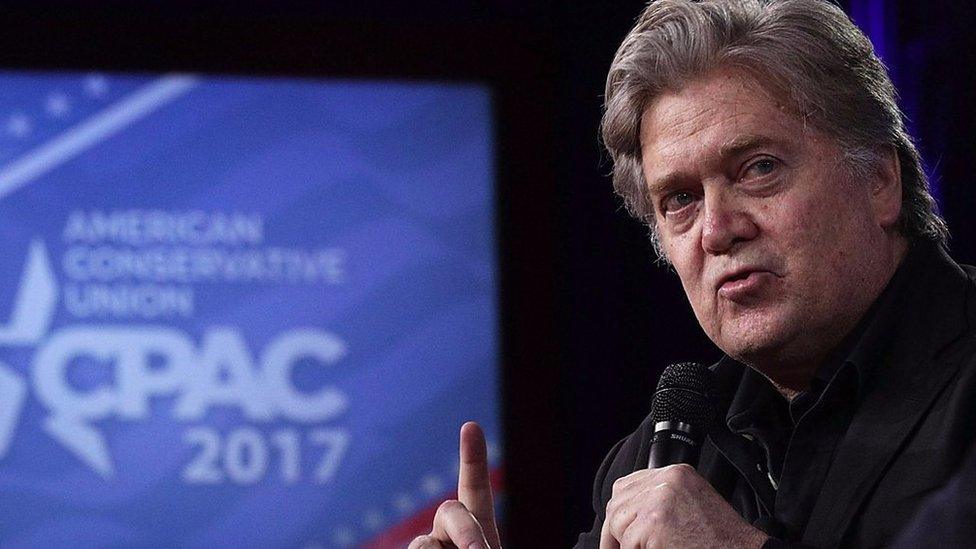Steve Bannon: The Trump-whisperer's rapid fall from grace
- Published
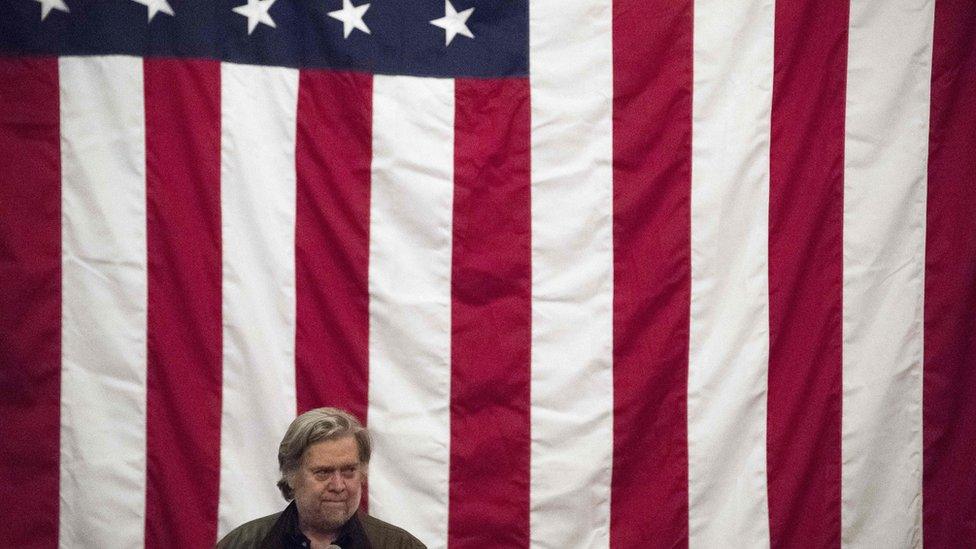
In the end, the master provocateur ended up provoking the wrong person in the wrong way at the wrong time.
Until August 2017, Steve Bannon was arguably the second most powerful man in Washington. The president's one-time chief strategist was the puller of strings, the Trump-whisperer, revelling in his role as an agent of chaos.
After the 2016 election, he was among "the best talent in politics" - in Trump's words.
Then he became "Sloppy Steve", a derogatory nickname used by the US president after Bannon was quoted in a book saying several things that appear to have made his former boss unhappy.
One example that made headlines was that the president's son, Donald Trump Jr, had committed a "treasonous" act in talking to Russians.
Bannon's backers cut their ties with him, he left the powerful right-wing media empire Breitbart, and the future of the man behind some of Trump's most headline-grabbing policies was left up in the air.
And then in August 2020, more bad news. Bannon was arrested and charged with fraud over an online fundraising scheme to build a wall on the US-Mexico border.
Prosecutors said he received more than $1m - and used some of it to pay off personal expenses. He pleaded not guilty.
Even in a White House where political careers have the life expectancy of a house fly, Bannon's sudden rise and fall over four years is remarkable. Here's how it came about.
Bannon joins Team Trump
17 August 2016
As executive chairman of Breitbart - a combative conservative site with an anti-establishment agenda - Bannon was an early cheerleader for Trump and Trumpism.
But it was not until 15 months into the property tycoon's presidential race that Bannon joined his team.
By that point he was already, according to a profile on the Bloomberg website, "the most dangerous political operative in America", a man with Democrats and establishment Republicans in his crosshairs, and a knack for well-timed confrontation. A disruptive Trump presented Bannon with a golden opportunity.
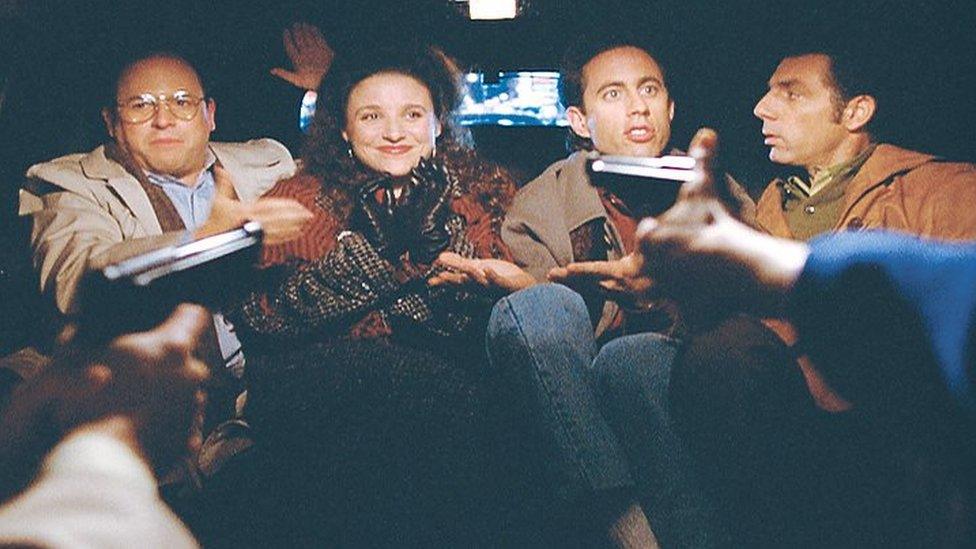
Without Seinfeld, there is no Steve Bannon - it will become clear, don't worry
Bannon was born into a family of Irish Catholics - all Kennedy Democrats - in Virginia in November 1953.
He was not political, he said, until an eight-year stint with the Navy starting in 1977, when he became a Reagan Republican in response to President Carter's handling of the Iran conflict.
A master of reinvention, he went on to work as an executive with the Goldman Sachs bank, before helping finance and produce Hollywood films and later emerging as a political Svengali.
His record in Hollywood can be described as patchy at best ("The business runs on talent relationships," one former colleague told the New Yorker., external "He had this real will-to-power vibe that was so off-putting.")
But Bannon did strike gold in one big way - by negotiating a share of the profits in a new television show, Seinfeld, in 1993. The show ran for nine seasons and was widely syndicated - in November 2016, Forbes estimated that Bannon, if he owned only a 1% share in the show's profits, would have earned $32.6m (£24m) by that point.
After returning to the US from the Chinese city of Shanghai in 2008 feeling the Bush administration was a "disaster", Bannon was struck by what he described to the New Yorker as "this phenomenon called Sarah Palin". Bannon warmed to the brand of populism employed by the Alaskan governor picked as John McCain's Republican running mate in the 2008 presidential race.
That populist wave would come crashing to shore with Trump's participation in the 2016 election, a wave Bannon proudly rode the whole way. In Trump, he recognised a willing outlet for his idea that, according to Wolff, "the new politics was not the art of compromise, but the art of conflict".
Bannon had long talked up Trump's chances on Breitbart News Network, which he took over in 2012 after the death of its founder, Andrew Breitbart. Bannon considered Trump, according to Wolff's book, "a big warm-hearted monkey".
Like many of the businessman's cheerleaders, Bannon was eventually invited into his inner circle, becoming the CEO of the Trump campaign in August 2016.
Dishevelled, regularly unshaven, and prone to wearing two shirts at the same time, he was an unlikely candidate to work closely with Trump, who places a high value on appearance. But somehow it worked.
Bannon's economic nationalist outlook and his eagerness for a "deconstruction of the administrative state" - a tearing apart of the system of taxes and regulations that he believed had hindered the US over years - chimed with Trump's "Make America Great Again" plea.
Two days after his arrival, Bannon replaced Paul Manafort as campaign chairman.
Bannon's counterpart in the Democratic camp, Robby Mook, responded furiously: "Donald Trump has decided to double down on his most small, nasty and divisive instincts by turning his campaign over to someone who is best known for running a so-called news site that peddles divisive, sometimes racist... sometimes anti-Semitic conspiracy theories."
The provocateur in Bannon will almost certainly have enjoyed the reaction to his appointment. Less than three months later, he'd have even more to celebrate.
Winning bigly
8 November 2016
Trump and Bannon thought as one in the last weeks of the campaign, to the extent that the Republican candidate would often demand: "Where's my Steve? Where's my Steve?", external, according to one former Trump aide.
In interviews after the event, Bannon said he always believed Trump would win. But not everyone else did, according to Michael Wolff's book. Indeed, in the weeks after the billionaire won, "he had come to credit Bannon with something like mystical powers" for having predicted the victory.
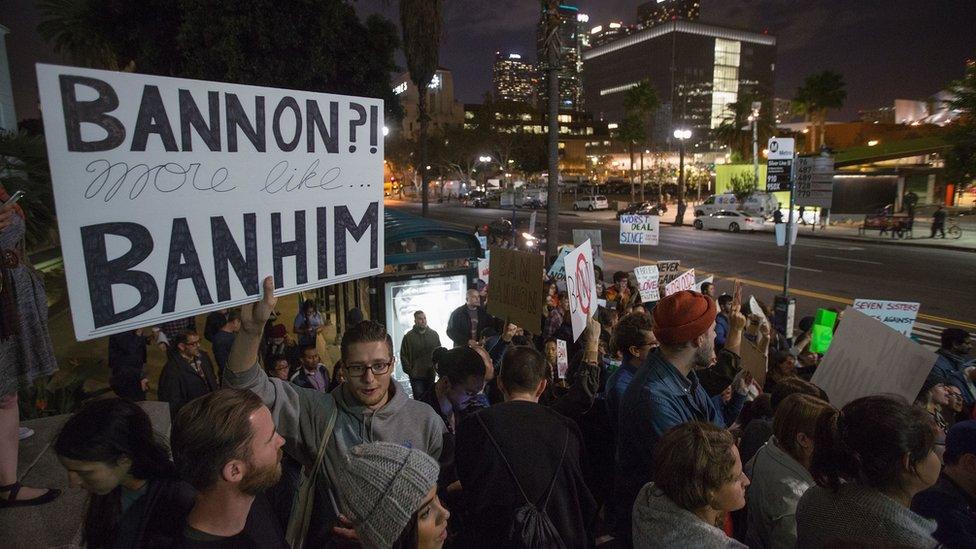
White House appointments aren't often met with wide protests - but then Steve Bannon's was no ordinary appointment
Days after the election, Trump named his trusted lieutenant as "chief strategist" - a newly created role - in his cabinet.
There were wide protests against the decision, and 169 members of the House - all Democrats - sent a letter to the president-elect asking him to withdraw Bannon's nomination, external, saying "bigotry, anti-Semitism, and xenophobia should have no place in our society, and they certainly have no place in the White House".
Bannon's vision was made clear in Trump's bleak inaugural address, which he wrote. Wolff says in his book it was "a Bannon-driven message to the other side that the country was about to undergo profound change... his take-back-the-country, America-first, carnage-everywhere vision of the country".
The "American carnage" speech painted a vision of a US with "mothers and children trapped in poverty in our inner cities, rusted-out factories scattered like tombstones across the landscape of our nation".
The full ramifications of Bannon's America First policy were made clear a week later, with Trump signing an executive order dreamt up by his chief strategist that banned people from seven Muslim-majority countries from travelling to the US. It caught many White House staff unaware.
Bannon, Wolff writes, was "satisfied" at the move and the subsequent outrage. "He could not have hoped to draw a more vivid line between the two Americas - Trump's and liberals'," Wolff writes, adding that the timing of its release before a busy weekend was deliberate - so it could cause as much chaos as possible.
One word that regularly features in interviews with Bannon is "war". Trump HQ on election night was "the war room", the same name he gave to the Oval Office when Trump took over. When Bannon would go on to leave the White House, he said he was going to "war" on Trump's behalf.
For Bannon, disorder was the new order in the White House. He and Trump were creating conflict and confusion, and that suited Bannon just fine.
A seat at the big table
28 January 2017
Steve Bannon's three goals for the Trump presidency
A day after Trump's executive order on immigration was signed, there was another controversial announcement - the US president downgraded military chiefs of staff from his National Security Council and gave a regular seat to Bannon instead.
Only career diplomats and generals usually join the council, the main group advising the president on national security and foreign affairs. By being invited to be a member, Bannon - in his first government job, aged 63 - was allowed to join high-level discussions about national security.
The reaction was, predictably, one of shock.
Democrat former presidential candidate Bernie Sanders called the move "dangerous and unprecedented", and Obama's former national security adviser Susan Rice tweeted: "This is stone-cold crazy. After a week of crazy."
The White House, of course, defended their man as being more than capable enough to be on the council, pointing out his Navy service.
But in retrospect, this promotion is about as good as it got for Bannon in the White House.
Bye Bye Bannon (part one)
18 August 2017
Some of the people who have resigned or been fired under President Trump
In the end, Bannon lasted a little over two months on the National Security Council, leaving in April.
It was not a demotion, White House officials said, but the reasons for the change were not clear. Perhaps, just by shaking up the old order, the appointment had done its job.
But this change in his responsibilities became an indication of what was to come.
After a summer of reports that Bannon was less and less visible in a White House suffering infighting and leaks, he left his position last August.
It was sold as a strategic move - Bannon would head back to Breitbart, where he would fight for Trump's agenda. "I've got my hands back on my weapons," he said. "It's Bannon the Barbarian."
Allow X content?
This article contains content provided by X. We ask for your permission before anything is loaded, as they may be using cookies and other technologies. You may want to read X’s cookie policy, external and privacy policy, external before accepting. To view this content choose ‘accept and continue’.
Breitbart welcomed back what it called its "populist hero", with editor-in-chief Alex Marlow saying Bannon had "his finger on the pulse of the Trump agenda".
But his departure from the White House came at the end of a week in which Bannon had come under fire from a number of quarters, and amid reports of tension with key aides including National Security Adviser HR McMaster.
Charlottesville was the culmination of months of protests by white supremacists
Clashes had taken place the previous weekend between far-right and counter-protesters in Charlottesville, Virginia, after which Trump blamed "both sides" for the violence - Bannon had once said his Breitbart site was "a platform for the alt-right", external who were responsible for the violence.
Two days before he left his job, an interview with Bannon in the American Prospect, a liberal magazine, reportedly infuriated the president. Bannon was quoted as dismissing the idea of a military solution in North Korea, undercutting Trump.
Then, a day later, a BuzzFeed report that said that Trump was unhappy with the credit his adviser was taking, external for the election victory.
"He undermined Trump's ego," Joshua Green, the author of a book on Bannon's relationship with Trump, Devil's Bargain, told the BBC.
"Trump can't abide the thesis of my book and Michael Wolff's book, which is that Bannon is the brains of the operation and Trump is an erratic charlatan. That's what Trump won't abide."
A humiliating loss
12 December 2017
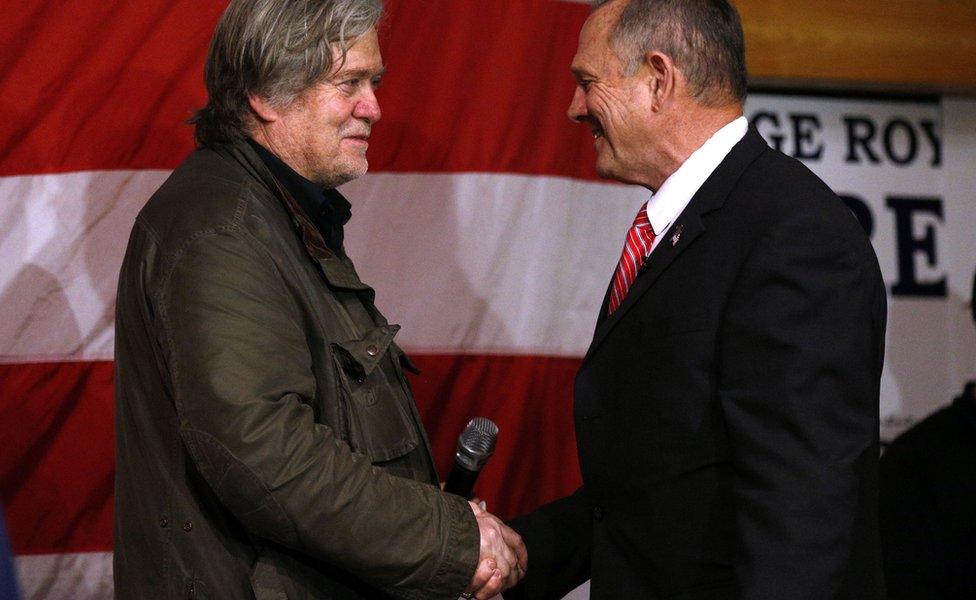
Bannon backed Roy Moore in the Alabama senate race - it didn't end well for them
Now on the outside looking in, Bannon was more than happy to tell Trump where he thought he was going wrong. He attacked him through Breitbart for reversing course and sending more troops to Afghanistan, and called Trump's firing of FBI director James Comey the biggest mistake in "modern political history".
But Bannon was back in his natural habitat as he gunned for the Republican establishment, putting his weight behind ultra-conservative populist candidate Roy Moore in a senate race in Alabama.
Moore comfortably won the primary against Luther Strange, the incumbent backed by Trump and the Republican machine.
Roy Moore: 'Sexual perversion and sodomy sweep this land'
But Moore went on to face allegations of sexual misconduct with teenage girls, which he denied, and in December he lost the race to Doug Jones, who became the first Democrat to win a Senate seat in Alabama in 25 years.
Bannon's man, one eventually backed by Trump and the Republican party, had suffered a humiliating loss in what was supposed to be Bannon's first big victory. A win would have given him momentum in his campaign to field populist candidates against Republican senators in the 2018 mid-terms. A loss made that much harder.
Bannon - humbled, surprised - credited Democrats for having worked hardest, but the defeat risked grounding his populist movement to a halt.
Bye Bye Bannon (part two)
9 January 2018
Trump harsher on Bannon than he is on his 'worst enemies'
Trump may once have been Bannon's "big warm-hearted monkey". But even cuddly monkeys can bite.
As details of Michael Wolff's book emerged, one key line stood out - Bannon described a meeting Donald Trump Jr held in New York with a Russian lawyer during the 2016 presidential election campaign as "treasonous".
"They're going to crack Don Junior like an egg on national TV," he told Wolff.
The reaction from the White House - reeling from a special-counsel investigation into possible collusion between the Trump team and Russia - was swift. Bannon had "lost his mind" after losing his White House position, the president said.
Allow X content?
This article contains content provided by X. We ask for your permission before anything is loaded, as they may be using cookies and other technologies. You may want to read X’s cookie policy, external and privacy policy, external before accepting. To view this content choose ‘accept and continue’.
Soon after, Rebekah Mercer, a wealthy benefactor of Bannon's, said she had ended her support for his political efforts.
Bannon, left with fewer and fewer allies, insisted his comments were not directed at Mr Trump's son but at another former aide, Paul Manafort, who was also present at the meeting in Trump Tower.
But there was only one way left to go. The goodbye from Breitbart was polite, and Bannon was out.
Somewhere, somehow, Bannon the master string-puller will re-emerge - possibly in a different guise.
Could he and Trump ever reconcile?
"Trump has fired people before and then let them back in," Joshua Green, the author of Devil's Bargain, said.
"But I've never seen Trump bury somebody as forcefully as he did Bannon, both in his statement and the parade of White House officials who have come out to heap scorn and derision on Bannon.
"It's awfully hard to imagine how Bannon could recover from that."
That wall and criminal charges
20 August 2020
An unexpected twist unfolded ahead of the November 2020 election when Bannon and three other people were arrested and charged with fraud over a fundraising campaign to build a wall on the US-Mexico border.
You'll remember that building this wall was a key pledge of Trump's 2016 campaign, which Bannon played a leading role in.
Bannon, Brian Kolfage, Andrew Badolato and Timothy Shea defrauded hundreds of thousands of donors in connection with the "We Build the Wall" campaign, which raised $25m (£19m), the Department of Justice (DoJ) said.
Bannon received more than $1m, at least some of which he used to cover personal expenses, the DoJ said.
Each of the two charges - conspiracy to commit wire fraud and conspiracy to commit money laundering - carries a maximum penalty of 20 years in prison.
- Published11 May 2024
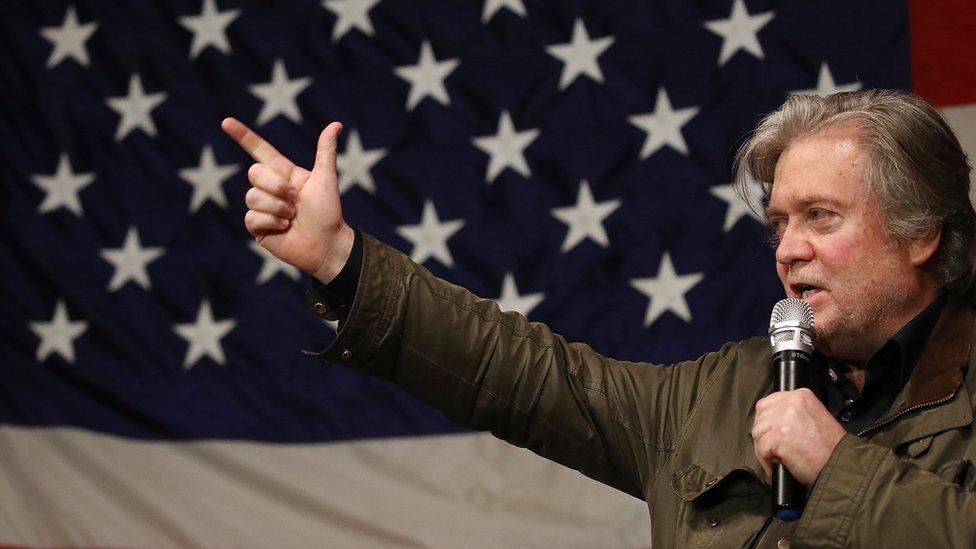
- Published5 January 2018
- Published9 January 2018
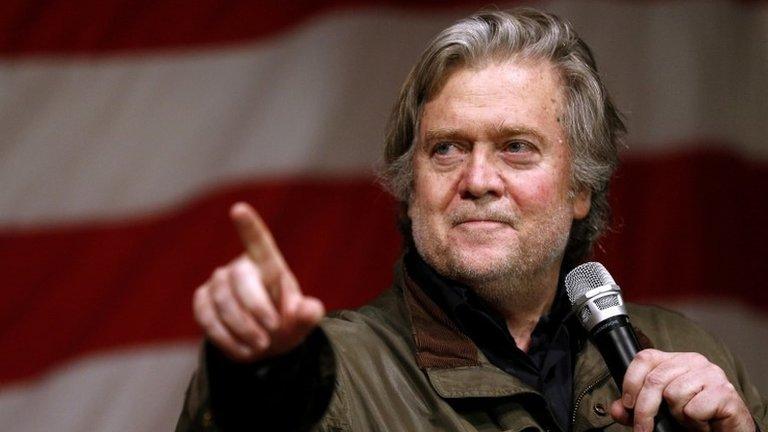
- Published23 February 2017
